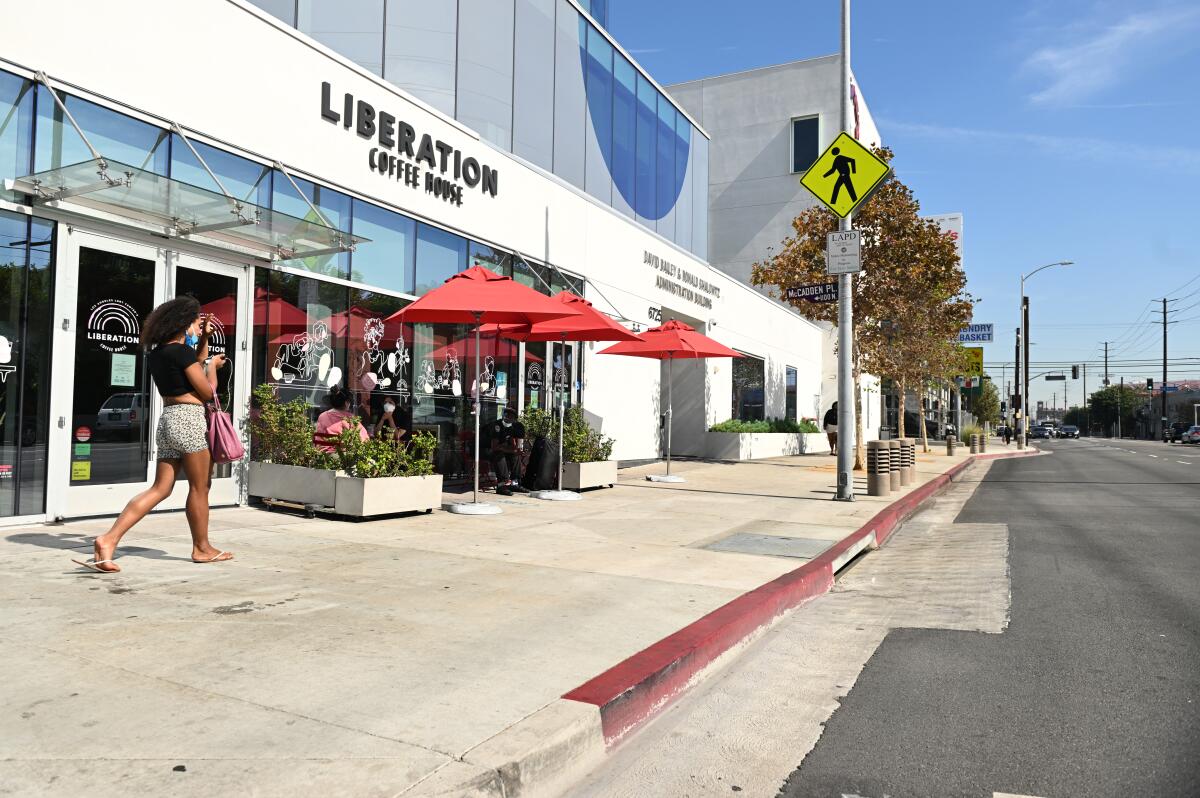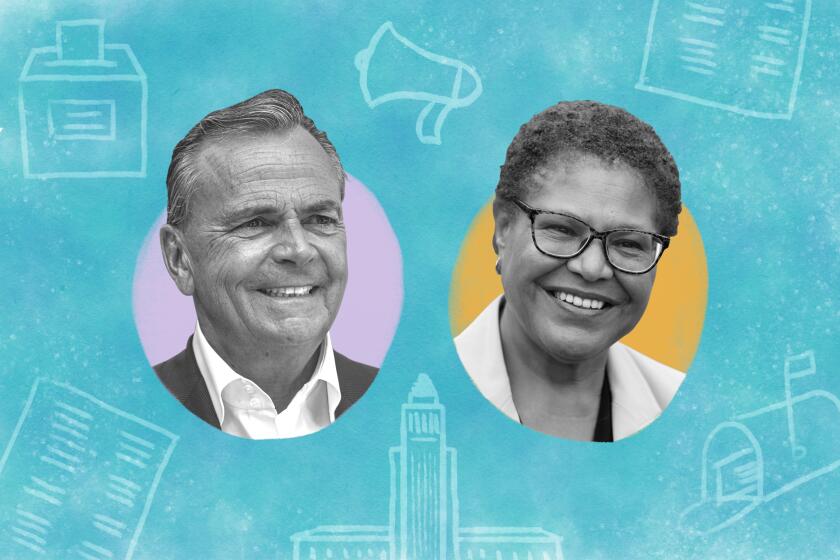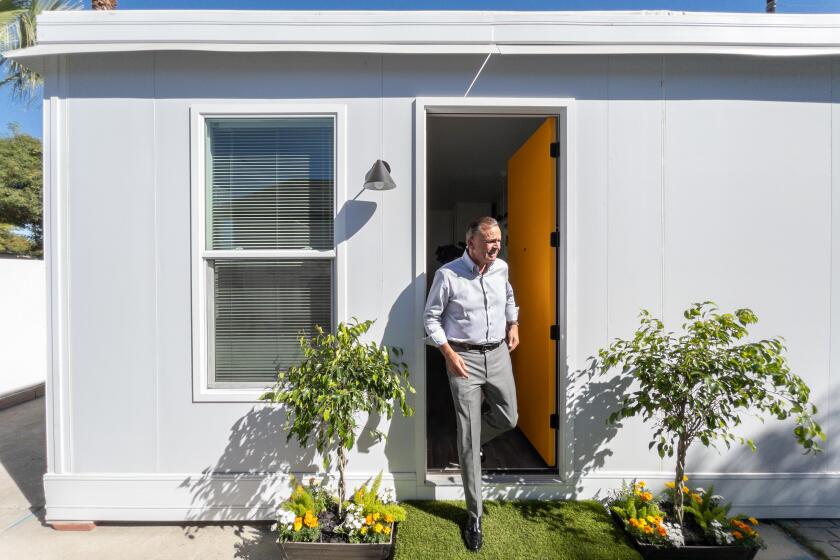Column: A $2-million ‘bike lane to nowhere’ symbolizes L.A.’s outrageous dysfunction

- Share via
On a short stretch of Santa Monica Boulevard in Hollywood is a sidewalk cutout that was billed as a bike lane.
A short half-block long, it took about 18 months to complete and cost roughly $2 million, and yet it is not marked as a bike lane and does not connect to one.
“It’s a bike lane to nowhere,” said Stephen Burn, general manager of building services at the Los Angeles LGBT Center, which was required to complete and pay for the project as a condition of approval.
Burn apologized for calling it a stupid waste of time and money that delayed the opening of badly needed supportive housing and social services, but no apology was necessary. He said he honestly wanted to pull his hair out at times when dealing with various government agencies, and after he shared the details, I wanted to pull my hair out.
I’m bringing this up now, on the eve of elections, for a reason.
The campaign focus on strategies around homelessness, crime and housing in the mayoral and City Council elections is certainly warranted. But let’s not forget that L.A. is desperate for a mayor and other leaders who will crack down on ineptitude, call out nonsense, and deliver basic services.
Rick Caruso and Karen Bass are running for Los Angeles mayor. Here is your guide to the race.
I hear frequently from frustrated taxpayers who get the runaround, or no response at all, when they try to get attention for various municipal breakdowns.
In recent days, a North Hollywood resident complained of encampments multiplying despite the promise of relief after the opening of a tiny home village she supported, and she asked, “When did our city officials become indifferent to their constituents’ pleas for help?”
A Venice resident sent me photos of knee-high trash on Lincoln Boulevard and said he’d made multiple efforts to get someone to clean it up. Finally, it was cleared. But 24 hours later, another landfill appeared. “The lack of attention, basic services and sanitation continues to be untenable,” he said.
In a city that has paid out tens of millions of dollars in settlements for injuries caused by ruptured sidewalks, I pulled up to a doozy a few days ago on Vineland Avenue in North Hollywood. The sidewalk looked like a skateboard ramp in a “Jackass” movie.
I could go on and on, but let’s get back to Santa Monica Boulevard and the LGBT Center, which I first toured a few weeks ago with mayoral candidate Karen Bass. She sighed and shook her head when staffers told her about the headaches and mounting costs involving the carved-out lane that fronts the building’s property, and she asked if anyone at City Hall had come to their rescue.
There was a bit of help, but not enough. I was curious to find out more, so I later returned to the center to hear the details.
A lot of new buildings in Los Angeles are set back farther from the street, but not necessarily for the sake of bikes. Critics, in fact, have said the real goal is to make more room for vehicles.
At the center, though, Burn was told from the beginning by public officials that his building’s sidewalk carve-out was part of a long-term bike lane project, and a long trail of documents back him up. By the way, I think the city needs more bike lanes, but design and location are key, and this project flunks both tests.
Burn and I paced off the supposed bike lane, which is about 150 feet long, starting mid-block and ending at McCadden Place. There’s no bikeway just east of there, outside a 7-Eleven strip mall, and no bike lane just west of there, where there’s a pawn shop and a doughnut shop.
There weren’t many cyclists in sight — possibly because it’s dangerous to pedal along a busy thoroughfare with a stop-and-go shoulder. The carve-out appears to be used more as a right-turn lane for cars and trucks, which makes it all the more dangerous for bikes.
But the larger point, aside from the absurdity of considering that location for a bike lane, is the rigmarole the center was subjected to.
Burn told me the land for the center was purchased in 2012, with full support from local officials and the community, and yet 10 years later, the paperwork is not complete. The first snag was a zoning change requirement, and Burn said that turned into a $1-million process.
Construction didn’t begin until 2016, and that’s when the bike lane came up. Burn said that stretch of Santa Monica Boulevard is technically a state road, and he was told that Caltrans and the city wanted a bike lane there, and that the property owner would have to foot the bill.
Center officials sought help from then-Councilman David Ryu, whose chief of staff, Sarah Dusseault, recalls thinking it was inappropriate to demand that a nonprofit provider of urgently needed services be on the hook for a bike lane in the midst of a humanitarian crisis.
“Why is this not a state infrastructure issue?” said Dusseault, who called both the demands and the design “all sorts of wrong.”
Dusseault went to work hunting for money to help out, but costs only grew when the Los Angeles Department of Water and Power got involved. Two wooden utility poles, with overhead lines, stood in the center of the proposed lane and had to be removed.
Power would have to be run underground, Burn was told, and the center would have to pay for a backup power line to serve the evolving needs of the surrounding neighborhood. Dusseault says that seemed to be an unfair burden, but there was no getting around it.
So the DWP went to work, but the madness did not end.
“The actual work of undergrounding the power didn’t take long,” Burn said. “But the poles didn’t get removed from the street, so we couldn’t complete the roadwork. … We didn’t know what the issue was and kept asking for them to come and take the poles away, but mostly our requests were unanswered.”
Burn was eventually told the overhead wires included “internet connectivity” lines and “DWP had nothing to do with it and couldn’t find anyone to say, ‘Those are our wires.’”
L.A. mayoral candidates Rick Caruso and Karen Bass say housing for homeless people and others can be high quality and much cheaper.
Months passed. Insurance costs rose. Financial juggling was required, even though Dusseault dug out some public money to help defray the cost of the project. Permits expired and applications had to be resubmitted. Aspects of the overall development of the center were delayed.
Dozens of housing units for seniors and youths, along with an array of social services, were finally in place by last year, and the LGBT Center is helping to save and rebuild lives on a daily basis. But full operation was delayed by close to a year, Burn said, and when people are shocked to hear the high cost of homeless housing units and how long it takes to put people into beds, it’s because of just what the LGBT Center has experienced.
The saddest thing is that these kinds of problems are not the exception in Los Angeles; they’re the rule. I hear about them all the time from service providers and developers who say it’s not this bad in other cities. They speak in tortured tones about what Burn called a “Kafkaesque” experience in managing the often conflicting demands of multiple agencies.
One inspector would say do it this way, another inspector would show up and contradict the other inspector. City electrical inspectors said they were available only after or before regular work hours, often at around 4 a.m., when overtime pay applies.
No fewer than nine funding sources were used in the LGBT project, each with its own attorneys and rules. Burn said two cutaway ramps for wheelchair access on McCadden have been ordered redone three times because of conflicting inspections and demands, adding about $100,000 in costs.
“This is not free money,” Burn said of cost overruns of at least $2 million on all aspects of the project. “It means not spending it on feeding people, on housing them, on helping them with legal issues or domestic violence, on teaching them to read.”
This villainous level of bureaucratic dysfunction and political impotence is stupefying, and over the years we’ve heard plenty of candidates vow to clear out the rot, streamline services, and finally make City Hall work for the people.
Karen Bass and Rick Caruso follow in that tradition of big promises, and whoever wins, we’ll be watching.
steve.lopez@latimes.com
More to Read
Sign up for Essential California
The most important California stories and recommendations in your inbox every morning.
You may occasionally receive promotional content from the Los Angeles Times.













